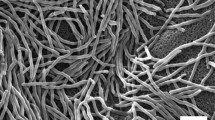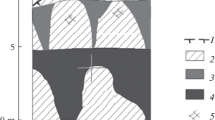Summary
The distribution of Chromobacterium on islands of the Scotia Ridge and Antarctic Peninsula was monitored during 1975–81. Three groups of strains were recognized: (1) an acid-tolerant group at South Georgia (pH<4.6); (2) a group occurring between pH 4.6 and 6.0 which contained most terrestrial isolates; and (3) a group occurring in mineral material, lakes and their sediments where pH was invariably <6.1. Chromobacteria were rarely detected at moisture levels <500% dry weight. Occurrence of the genus has previously been under-estimated because of its poor competitive ability. Media selective for northern strains proved inhibitory and a new selective medium containing Nalidixic acid, Penicillin and 0/129 Pteridine derivative was developed. Distinctive taxonomic and antibiotic sensitivity patterns were recognized. Terrestrial Antarctic isolates were closely related to Chromobacterium (= Janthinobacterium) lividum but differed in certain diagnostic features. Most notable was the ability of Antarctic strains to produce acid from trehalose which is widespread in Antarctic micro-flora and -fauna. Antarctic isolates resisted significantly fewer antibiotics than the northern temperate type culture.
Similar content being viewed by others
References
Boyd WL, Staley JT, Boyd JW (1966) Ecology of soil microorganisms of Antarctica. Antarct Res Ser 8:125–159
Collins NJ, Baker JH, Tilbrook PJ (1975) Signy Island, maritime Antarctic. Ecol Bull 20:345–374
Collins VG, Willoughby LG (1962) The distribution of bacteria and fungal spores in Blelham Tarn with particular reference to an experimental overturn. Arch Mikrobiol 43:294–307
Ellis-Evans JC (1981) Freshwater microbiology at Signy Island South Orkney Islands, Antarctica. PhD Thesis, Council for National Academic Awards, 282pp (unpublished)
Holdgate MW (1977) Terrestrial ecosystems in the Antarctic. Philos Trans R Soc London, Ser B 279:5–25
Innis WE, Mayfield CI (1979) Effect of temperature on violacein production in a psychrotrophic Chromobacterium from Lake Ontario sediment. Microbial Ecol 5:51–56
Keeble JR, Cross T (1977) An improved medium for the enumeration of Chromobacterium from soil and water. J Appl Bacteriol 43:325–327
Kriss AE, Mitskevich IN, Rozanova EP, Osnitskaya LK (1977) Microbiological investigations of Lake Vanda (Antarctica). Microbiol 45:917–922
Lindeboom HJ (1979) Chemical and microbiological aspects of the nitrogen cycle on Marion Island (sub-Antarctic). PhD Thesis, Rijksuniversiteit Groningen, 138pp (unpublished)
Moss MO, Ryall C (1981a) Distribution of Chromobacteria in a lowland river. Microbial Ecol 7:139–149
Moss MO, Ryall C (1981b) The genus Chromobacterium. In: Starr MP, Stolp H, Trüper HG, Balows A, Schlegel HG (eds) The prokaryotes. Springer, Berlin Heidelberg New York, pp 1355–1364
Moss MO, Ryall C, Logan NA (1978) The classification and characterization of Chromobacteria from a lowland river. J Gen Microbiol 105:11–21
Nelson LM (1977) Growth and survival characteristics of three Arctic bacteria in Truelove Lowland. In: Bliss LC (ed) Truelove Lowland, Devon Island, Canada: A high Arctic ecosystem. University of Alberta Press, Edmonton, pp 547–565
Parmelee DF, Fraser WR, Neilson DR (1977) Birds of the Palmer Station area. Antarct J US 12:15–21
Ryall C, Moss MO (1975) Selective media for the enumeration of Chromobacterium spp. in soil and water. J Appl Bacteriol 38:53–59
Smith MJ (1981) Cellulose decomposition on South Georgia. Br Antarct Surv Bull 53:264–265
Smith RIL (1982) Farthest south and highest occurrence of vascular plants in the Antarctic. Polar Rec 21:170–174
Smith RIL, Walton DWH (1975) South Georgia, subantarctic. Ecol Bull 20:399–424
Sneath PHA (1974) Chromobacterium. In: Buchanan RE, Gibbons NE, (eds) Bergey's manual of determinative bacteriology, 8th edn. Williams and Wilkins, Baltimore, pp 354–357
Sneath PHA (1977) Identification methods applied to Chromobacterium. Soc Appl Bacteriol Tech Ser 14:167–176
Sømme L, Block W (1982) Cold hardiness of Collembola at Signy Island, maritime Antarctic. Oikos 38:168–176
Tilbrook PJ (1973) The Signy Island terrestrial reference sites. 1. An introduction. Br Antarct Surv Bull 33, 34:65–76
Wynn-Williams DD (1979) Techniques used for studying terrestrial microbial ecology in the maritime Antarctic. Soc Appl Bacteriol Tech Ser 13:67–82
Wynn-Williams DD (1980) Seasonal fluctuations in microbial activity in Antarctic moss peat. Biol J Linn Soc 14:11–28
Wynn-Williams DD (1982) Simulation of seasonal changes in microbial activity of maritime Antarctic peat. Soil Biol Biochem 14:1–12
Author information
Authors and Affiliations
Rights and permissions
About this article
Cite this article
Wynn-Williams, D.D. Distribution and characteristics of Chromobacterium in the maritime and sub-antarctic. Polar Biol 2, 101–108 (1983). https://doi.org/10.1007/BF00303175
Received:
Accepted:
Issue Date:
DOI: https://doi.org/10.1007/BF00303175




